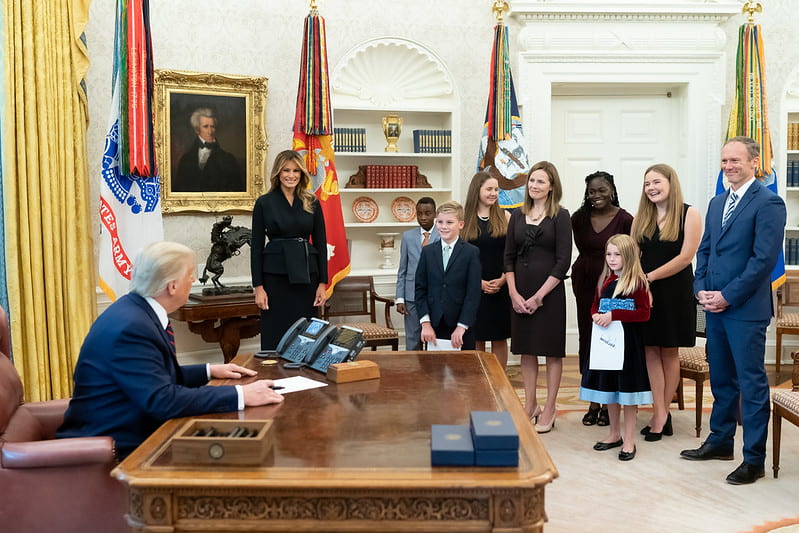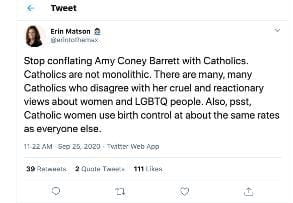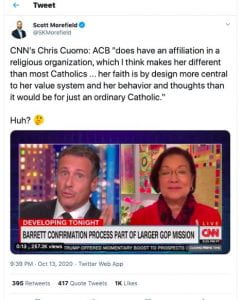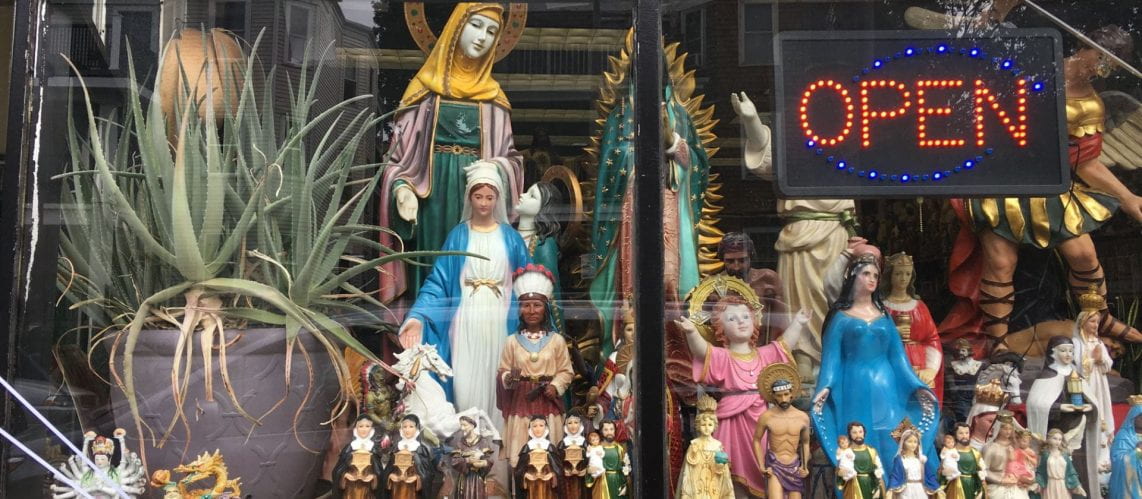By Lauren R. Kerby and Mary Perez
Lauren R. Kerby is the religious literacy specialist for Religion and Public Life at Harvard Divinity School, as well as a lecturer on religious studies at Harvard Divinity School and Harvard Extension School.
Mary Perez is a second-year Master of Divinity candidate at Harvard Divinity School. She has previously taught in Catholic elementary and high schools in Maryland, Tennessee, and California.
When Amy Coney Barrett was nominated to the Supreme Court, her religious identity as a conservative, charismatic Catholic immediately became a subject of intense scrutiny. On one level, the American public and their representatives in Congress were interested in how Barrett’s religious commitments might influence her judicial work. But on another level, the public conversation about Barrett’s identity reveals the internal diversity of how American Catholics think about what it means to be a Catholic woman, mother, and even feminist.
In conversations about the internal diversity of religious traditions, it is important to help students identify both the various positions within a tradition and the relative power/influence they hold. Internal diversity never means that all points of view occupy a level playing field within a tradition. Rather, some voices will be louder than others, and some will speak from the margins. For those seeking religious literacy, the conversations between those two positions will reveal more about the tradition than either one does in isolation.
This lesson offers an opportunity for students to 1) practice recognizing internal diversity and 2) ask new questions about a topic as a result. The habits of mind we advocate at Religious Literacy + Education are not ends in themselves. We want students to be able to recognize that religions are internally diverse, historically dynamic, and embedded in culture so that they can ask deeper, smarter questions about religion when they encounter it. The recursive dimension of this exercise–returning to Frey’s USA Today essay–allows them to experience how their questions change when they start from a place of recognizing religion’s complexity.

Part 1: Authentic but not exclusive
In a religious studies classroom, students should be familiar with the distinction between devotional and nondevotional ways of speaking about religion. When they encounter devotional statements in what they study, or in the conversations they have among themselves, one strategy many RPL teachers find helpful is to recognize that such statements are “authentic but not exclusive.” That is to say, while these devotional expressions are sincere and authentically reflect the experience of the speaker, they are not the exclusive speakers on behalf of their religious traditions. Others within their tradition may have differing perspectives, which are also authentic but not exclusive.
We suggest reminding students of this framing before assigning them to read the following article and consider the discussion questions:
Jennifer A. Frey, “Like Amy Coney Barret, I’m a professional woman criticized for my big, Catholic family,” op-ed, USAToday, October 15, 2020.
- What does Frey mean by “faithful Catholic”? What can you infer about what she means from what she shares about herself and others in her essay? (Teachers: consider asking students to make a list of things that make one a “faithful Catholic” in Frey’s view.)
- Frey differentiates between what “culture” says about women’s roles and what her Catholicism says. What do you see as the difference? In your experience, what has the culture you participate in (social media, tv/movies, books, news) told you about women’s roles?
Part 2: Complicating the narrative
Once students have identified Frey’s perspective, they may already be asking questions about internal diversity. Even if they are not, this next set of articles offers a variety of perspectives on how Catholic women think about the issues raised by Frey.
We suggest asking students to pick two sources from the list below and identify in them examples (2-3) of women who agree or disagree with what Frey says about what it means to be a “faithful” Catholic woman. As always, we want students to observe this internal diversity, not adjudicate who is more right in this debate.
Mary Hallan FioRito,“Pope St. John Paul II and the ‘Feminine Genius’ of Amy Coney Barrett,” October 19, 2020. (agreeing with Frey)
Alejandra Molina, “Amy Coney Barrett nomination fight leaves progressive Catholics feeling unseen,” Religion News Service, October 12, 2020. (mostly disagreeing with Frey)
Abby Palko, “My experience as a working mother at Notre Dame was much different from Amy Coney Barrett’s,” Slate, October 22, 2020. (disagreeing with Frey) Note: This reading spotlights structural violence for those looking to bring Galtung into the conversation.
Samantha Schmidt and Sarah Pulliam Bailey, “Many Catholic women see themselves in Amy Coney Barrett. Others see an impossible standard,” The Washington Post, October 13, 2020. (agreeing and disagreeing with Frey)
Women-Church Convergence, “Women Church convergence deplores nomination of Amy Coney Barrett,” October 21, 2020. (disagreeing with Frey)
- Identify an example of a woman who agrees with Frey’s understanding of what it means to be a faithful Catholic woman. What similarities do you notice? Are there differences you can find?
- Identify an example of a woman who disagrees with Frey’s understanding of what it means to be a faithful Catholic woman. What are her main points of disagreement? Can you find things they do agree on?
- Looking at Frey’s essay and the examples you just identified, what sources of authority is each woman guided by in her tradition? Be as specific as you can. (Note to teachers: this might include the Vatican, the pope, the Bible, saints, individual experience, Catholic social justice teachings, etc.). What do you learn from this about internal diversity?
Part 3: Asking better questions
The last step of this lesson is to ask students how they would read Frey’s essay differently knowing what they now do about the internal diversity of Catholic women’s positions. If the previous sections of this lesson have been done in small groups, we recommend doing this portion as a full class, since students may have read different articles.
- Look back at Frey’s essay and highlight at least three places where you think some of the other women you’ve read about would disagree.
- If you were interviewing Frey for an article you were writing, what are three questions you would ask her now that you might not have known to ask at the beginning of class?
Bonus section: Data!
In our experience, many students and teachers like to have data to support claims about internal diversity, rather than (or in addition to) the anecdotal experience of individual writers. This section includes some sources you can offer your students to practice reading and interpreting statistics.
Before reading, it may be helpful to ask students to surface their assumptions about the data points they will encounter in the source. For instance, you might ask them to write down their assumptions about Catholics’ political party affiliation, race/ethnicity, views on abortion, and so on. After reading, they can reflect on how the data disrupted their assumptions or confirmed them.
“Catholics,” Religious Landscape Study, Pew Forum, 2015. This source includes data on Catholics’ political affiliation and views on abortion, as well as demographic data about age, race, gender, and geographic location.
Mark M. Gray and Mary L. Gautier, “Catholic Women in the United States: Beliefs, Practices, Experiences, Attitudes,” Center for the Applied Research in the Apostolate, 2018. On pages 6-7, the charts illustrate responses to the question,” How important are the following factors to your sense of what it means to be a Catholic?” On pages 30-31, the report offers data on responses about marital status and children.
Catholics for Choice, “The Facts Tell the Story: Catholics and Choice 2014-2015,” Washington, D.C., 2015. (NB: Catholics for Choice is a political organization advocating for pro-choice policies.) This source includes data on a wide variety of sexual issues among American Catholics, including contraception use and abortion.
Superbonus: Twitter!
Remember that social media is a great source for illustrating both internal diversity and religious illiteracy.



